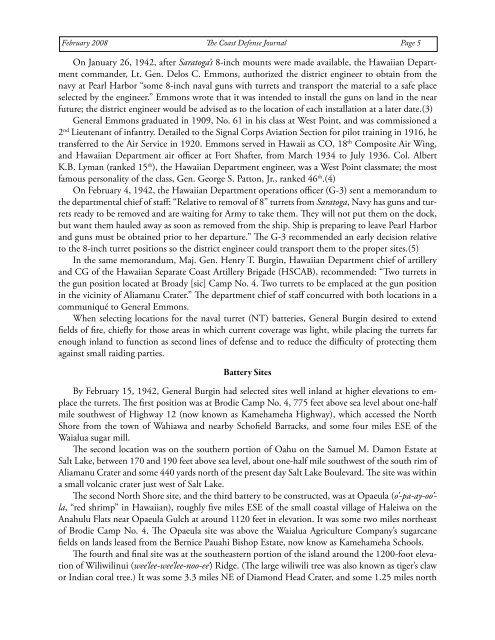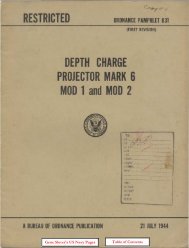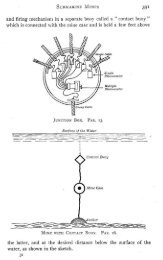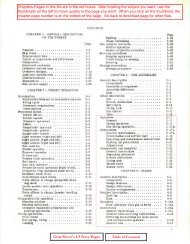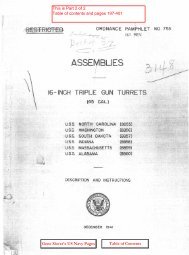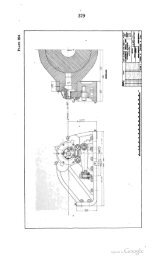Oahu's 8-inch Naval Turret Batteries 1942-1949 - Personal Page of ...
Oahu's 8-inch Naval Turret Batteries 1942-1949 - Personal Page of ...
Oahu's 8-inch Naval Turret Batteries 1942-1949 - Personal Page of ...
You also want an ePaper? Increase the reach of your titles
YUMPU automatically turns print PDFs into web optimized ePapers that Google loves.
February 2008 The Coast Defense Journal <strong>Page</strong> 5<br />
On January 26, <strong>1942</strong>, after Saratoga’s 8-<strong>inch</strong> mounts were made available, the Hawaiian Department<br />
commander, Lt. Gen. Delos C. Emmons, authorized the district engineer to obtain from the<br />
navy at Pearl Harbor “some 8-<strong>inch</strong> naval guns with turrets and transport the material to a safe place<br />
selected by the engineer.” Emmons wrote that it was intended to install the guns on land in the near<br />
future; the district engineer would be advised as to the location <strong>of</strong> each installation at a later date.(3)<br />
General Emmons graduated in 1909, No. 61 in his class at West Point, and was commissioned a<br />
2 nd Lieutenant <strong>of</strong> infantry. Detailed to the Signal Corps Aviation Section for pilot training in 1916, he<br />
transferred to the Air Service in 1920. Emmons served in Hawaii as CO, 18 th Composite Air Wing,<br />
and Hawaiian Department air <strong>of</strong>ficer at Fort Shafter, from March 1934 to July 1936. Col. Albert<br />
K.B. Lyman (ranked 15 th ), the Hawaiian Department engineer, was a West Point classmate; the most<br />
famous personality <strong>of</strong> the class, Gen. George S. Patton, Jr., ranked 46 th .(4)<br />
On February 4, <strong>1942</strong>, the Hawaiian Department operations <strong>of</strong>ficer (G-3) sent a memorandum to<br />
the departmental chief <strong>of</strong> staff: “Relative to removal <strong>of</strong> 8” turrets from Saratoga, Navy has guns and turrets<br />
ready to be removed and are waiting for Army to take them. They will not put them on the dock,<br />
but want them hauled away as soon as removed from the ship. Ship is preparing to leave Pearl Harbor<br />
and guns must be obtained prior to her departure.” The G-3 recommended an early decision relative<br />
to the 8-<strong>inch</strong> turret positions so the district engineer could transport them to the proper sites.(5)<br />
In the same memorandum, Maj. Gen. Henry T. Burgin, Hawaiian Department chief <strong>of</strong> artillery<br />
and CG <strong>of</strong> the Hawaiian Separate Coast Artillery Brigade (HSCAB), recommended: “Two turrets in<br />
the gun position located at Broady [sic] Camp No. 4. Two turrets to be emplaced at the gun position<br />
in the vicinity <strong>of</strong> Aliamanu Crater.” The department chief <strong>of</strong> staff concurred with both locations in a<br />
communiqué to General Emmons.<br />
When selecting locations for the naval turret (NT) batteries, General Burgin desired to extend<br />
fields <strong>of</strong> fire, chiefly for those areas in which current coverage was light, while placing the turrets far<br />
enough inland to function as second lines <strong>of</strong> defense and to reduce the difficulty <strong>of</strong> protecting them<br />
against small raiding parties.<br />
Battery Sites<br />
By February 15, <strong>1942</strong>, General Burgin had selected sites well inland at higher elevations to emplace<br />
the turrets. The first position was at Brodie Camp No. 4, 775 feet above sea level about one-half<br />
mile southwest <strong>of</strong> Highway 12 (now known as Kamehameha Highway), which accessed the North<br />
Shore from the town <strong>of</strong> Wahiawa and nearby Sch<strong>of</strong>ield Barracks, and some four miles ESE <strong>of</strong> the<br />
Waialua sugar mill.<br />
The second location was on the southern portion <strong>of</strong> Oahu on the Samuel M. Damon Estate at<br />
Salt Lake, between 170 and 190 feet above sea level, about one-half mile southwest <strong>of</strong> the south rim <strong>of</strong><br />
Aliamanu Crater and some 440 yards north <strong>of</strong> the present day Salt Lake Boulevard. The site was within<br />
a small volcanic crater just west <strong>of</strong> Salt Lake.<br />
The second North Shore site, and the third battery to be constructed, was at Opaeula (o’-pa-ay-oo’la,<br />
“red shrimp” in Hawaiian), roughly five miles ESE <strong>of</strong> the small coastal village <strong>of</strong> Haleiwa on the<br />
Anahulu Flats near Opaeula Gulch at around 1120 feet in elevation. It was some two miles northeast<br />
<strong>of</strong> Brodie Camp No. 4. The Opaeula site was above the Waialua Agriculture Company’s sugarcane<br />
fields on lands leased from the Bernice Pauahi Bishop Estate, now know as Kamehameha Schools.<br />
The fourth and final site was at the southeastern portion <strong>of</strong> the island around the 1200-foot elevation<br />
<strong>of</strong> Wiliwilinui (wee’lee-wee’lee-noo-ee’) Ridge. (The large wiliwili tree was also known as tiger’s claw<br />
or Indian coral tree.) It was some 3.3 miles NE <strong>of</strong> Diamond Head Crater, and some 1.25 miles north


